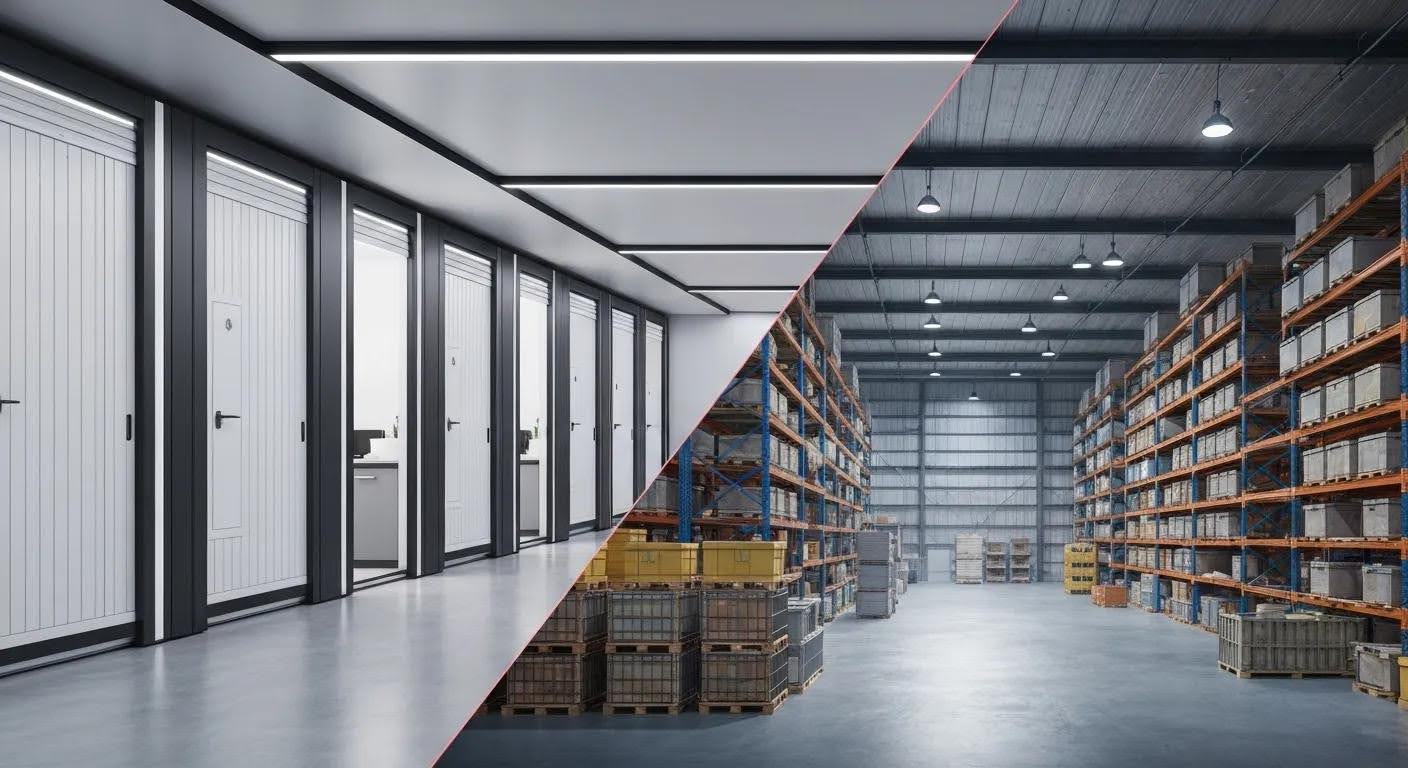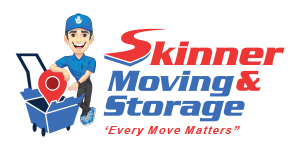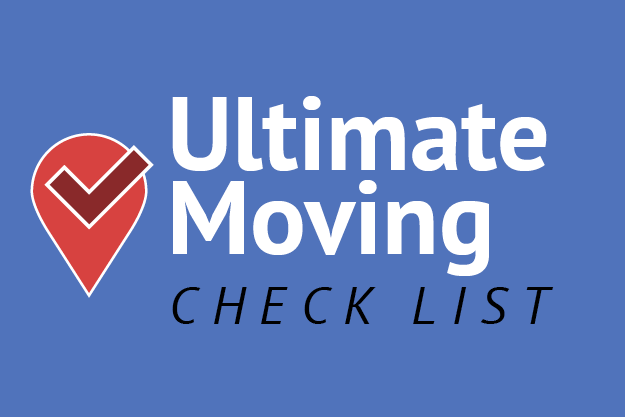Moving in Jacksonville raises a practical choice early: keep belongings in a portable storage unit parked at your property, or place them in an off-site warehouse with professional handling. This guide explains how portable storage units and warehouse storage differ, why Jacksonville’s climate and local logistics matter, and how to match storage solutions to common moving scenarios. You will learn definitions, cost drivers, security and climate considerations, access models, and a decision framework that aligns with short-term renovations, long-distance moves, and commercial inventory needs. Along the way, the guide compares on-site convenience against off-site protection and provides clear steps to evaluate price and value for your move. Read on for side-by-side comparisons, actionable checklists, and specific ways a local moving-and-storage provider can support a smooth transition.
What Are Portable Storage Units and How Do They Work in Jacksonville?
Portable storage units are weather-resistant containers delivered to your location so you can load at your pace; then the container is stored on-site, transported to a facility, or picked up for long-term storage. This approach reduces double-handling because you load directly into the unit and either keep it on your driveway or schedule pickup, which shortens active moving time and simplifies staging. Portable units work well in Jacksonville when driveway space, HOA rules, and permit requirements allow curbside placement, and when short-term access outweighs long-term protection. Understanding the delivery, loading, and pickup sequence helps decide whether the time savings and on-site access are worth potential exposure to humidity or limited security. If you’re unsure about what to do with unwanted items, consider the differences between Junk Removal vs Donation
What Is Portable Storage?
Portable storage is a modular container service where a provider drops a lockable unit at your property for loading, then retrieves and stores it or transports it to your destination. The mechanism—deliver → load → secure → transport—gives homeowners control over packing speed and staging, and reduces repeated lifting of items. Common container sizes vary by provider and typically accommodate partial to whole-home loads, enabling flexible use for renovations or temporary housing. This model relies on scheduled pickups and reliable delivery windows, which you should confirm before booking to ensure alignment with your move timeline.

What Are the Key Benefits of Portable Storage for Jacksonville Moves?
Portable units deliver practical advantages for local moves and home projects by combining convenience with flexibility. They allow you to load on your schedule, support phased moves or renovations, and reduce immediate moving labor costs through reduced double-handling. For Jacksonville specifically, on-site units simplify staging when listing a home and accommodate quick access during short projects; however, users must weigh exposure to humidity and the need for secure placement. These benefits make portable storage attractive for homeowners prioritizing access and timeline control. To stay organized, be sure to follow a Moving Checklist to streamline the process and ensure nothing is overlooked.
When Is Portable Storage Ideal for Jacksonville Residents?
Portable storage fits a set of clear scenarios where accessibility and timing are the priority rather than long-term climate protection. Typical use cases include renovation staging where items need temporary, nearby storage; short local moves where transporting once is efficient; and temporary housing transitions where frequent access is required. In each case, residents enjoy the convenience of directly loading possessions and keeping them immediately available. Knowing these scenarios helps you decide if portable units are more practical than off-site warehousing.
What Should You Consider Before Choosing Portable Storage?
Before choosing portable storage, assess driveway or curb space, HOA and local permit rules, and security and weather exposure for stored items. Consider whether hurricane season or high humidity could affect furniture and documents, and plan for adequate ventilation or protective wrapping. Confirm delivery and pickup scheduling windows, insurance coverage options, and whether the provider offers lock recommendations to reduce tampering risk. Evaluating these factors helps prevent surprises and aligns portable storage with your tolerance for access and exposure.
How Does Warehouse Storage in Jacksonville Compare to Portable Storage?
Warehouse storage is an off-site approach where a storage provider receives, inventories, and protects your belongings in a controlled facility; it emphasizes security, climate control, and professional handling rather than on-site convenience. Warehouse storage benefits high-value items, long-term needs, and commercial inventory because it reduces exposure to humidity, provides monitored security, and supports inventory management. Choosing warehouse storage shifts access to scheduled retrievals and moves handling responsibility to trained staff, which can reduce damage risk and streamline long-distance moves. Next, we describe specific warehouse features and how they address Jacksonville’s climate and long-term protection needs.
What Is Warehouse Storage and What Does Skinner Moving & Storage Offer?
Warehouse storage is an off-site facility solution that combines secure, monitored storage with professional handling and inventory procedures to protect items over longer durations. Skinner Moving & Storage operates a climate-controlled, 24-hour-monitored warehouse that supports short-term and long-term storage while addressing Jacksonville’s humidity challenges and the protection needs of sensitive items. This facility model reduces risk for antiques, electronics, and paper records through controlled temperature and humidity and continuous monitoring. For readers comparing options, requesting a storage quote from a local provider can clarify pricing and logistics specific to your move.
What Are the Main Benefits of Warehouse Storage for Jacksonville Moves?
Warehouse storage delivers enhanced protection and operational advantages: continuous monitoring reduces theft risk, climate control minimizes humidity damage, and professional handling decreases accidental breakage during loading and inventory. These benefits are especially important in Jacksonville, where humid coastal conditions accelerate mold, warping, and corrosion on untreated wood, textiles, and electronics. Warehouse services also support businesses with inventory rotation and document retention policies, providing organizational controls missing in temporary on-site solutions. Understanding these protections clarifies when off-site warehousing yields superior long-term value.
When Is Warehouse Storage the Best Option in Jacksonville?
Warehouse storage is the preferred option when items require long-term protection, climate stabilization, or professional inventory management—common in long-distance relocations, business inventory storage, and safekeeping of high-value possessions. For example, families moving out of state or owners storing antiques during an extended renovation benefit from a monitored, climate-controlled facility. Businesses storing seasonal inventory or archived records gain from organized shelving and handling logistics that reduce retrieval errors. These scenarios highlight how warehouse services mitigate environmental risks and logistical complexity.
What Are Important Considerations for Using Warehouse Storage?
Key considerations include access scheduling, inventory labeling and documentation, insurance and liability terms, and pickup/delivery coordination that may add handling fees or lead times. Expect scheduled retrieval windows and verification procedures for item access, plus professional packing options that further protect stored goods. Clarify insurance coverage for transit and storage periods, and confirm how inventory is tracked to streamline future retrievals. These operational details help you evaluate total cost and convenience when choosing warehouse storage.
How Do Portable Storage and Warehouse Storage Compare on Cost and Pricing in Jacksonville?
Cost differences between portable storage and warehouse storage hinge on rental duration, delivery and pickup fees, unit size or volume, climate control surcharges, and handling or inventory services. Portable solutions often include delivery and pickup charges plus a monthly rental, making short-term usage economical for local moves; warehouse pricing typically charges by volume or unit with additional handling and climate premiums, which can be more cost-effective for long-term or high-value storage. Comparing total landed cost—not just monthly rent—reveals which option offers better value for your specific move type. The table below breaks down typical cost drivers and their impact.
Before the table: this comparison shows how each cost factor changes the final price and where savings are most likely to appear.
| Storage Type |
Cost Factor |
Typical Impact |
| Portable Unit |
Delivery / pickup fees |
Significant for short rentals or long distances |
| Portable Unit |
Rental duration |
Higher for extended months; short stays often cheaper |
| Warehouse |
Climate control surcharge |
Adds premium for humidity/temperature management |
| Warehouse |
Handling fees |
Applies for inbound/outbound inventories and deliveries |
| Warehouse |
Volume-based pricing |
Tends to scale better for larger or long-term storage |
This cost breakdown demonstrates that portable storage can be cheaper for short, local uses, while warehouse pricing becomes more favorable for long durations and when climate protection is required.
What Factors Influence Portable Storage Costs in Jacksonville?
Several variables determine portable storage pricing locally: the distance between your property and the provider’s yard affects delivery and pickup fees; rental duration increases monthly costs; container size affects base rental; and any necessary permits or HOA fees add administrative cost. You can reduce costs by minimizing rental time, consolidating belongings into fewer containers, and scheduling pickups to avoid extra days in storage. Comparing provider quotes with explicit delivery and retrieval fees reveals the true cost of a portable solution.
How Are Warehouse Storage Prices Determined in Jacksonville?
Warehouse pricing commonly includes a base rate tied to the volume or footprint of items, plus surcharges for climate control and handling services, and possible minimum-term commitments. Monitoring and 24-hour security may be bundled into the monthly rate, while inventories requiring packing or palletization typically generate additional handling fees. Businesses often negotiate volume discounts or contract terms, while residential customers should clarify minimum storage periods and any move-in/move-out costs to evaluate overall value.
Which Storage Option Offers Better Value for Different Move Types?
Value depends on move type: short local moves and renovation staging often favor portable storage for convenience and lower short-term cost, while long-distance relocations and storage of sensitive or high-value items generally favor warehouse storage for protection and professional handling. Commercial moves that need inventory management will usually find warehouse services more efficient despite higher monthly rates. Use this simple scenario mapping to align selection with your priorities.
- Short local moves: portable storage often best for speed and lower short-term costs.
- Long-term or climate-sensitive storage: warehouse storage typically better value for protection.
- Commercial inventory: warehouse storage usually offers better handling and organization.
These scenarios clarify how cost and service features translate to practical value based on your move type.
What Are the Differences in Accessibility and Convenience Between Portable and Warehouse Storage?
Accessibility and convenience contrast sharply: portable units offer immediate, on-site access without scheduling, while warehouses provide controlled, scheduled access with professional retrieval processes. Portable storage supports frequent on-demand access during packing or renovation, minimizing transport steps. Warehouse access requires appointments, authorization, and sometimes lead times for item retrieval, but offers organized retrieval and reduced handling risk. Understanding these trade-offs helps pick a model aligned with how often you need items and how much convenience you want versus how much protection you require.
How Does On-Site Access with Portable Storage Benefit Jacksonville Movers?
On-site portable access benefits movers by enabling direct retrieval during packing, renovation, or staging without coordinating trips to a facility, which saves time and simplifies project management. Immediate access reduces the need to transport items multiple times and helps homeowners adjust staging as needed when selling or remodeling a property. The direct access model also shortens labor windows for movers and homeowners who prefer hands-on control. These advantages make portable storage especially helpful for projects where repeated access to items is expected.
What Are the Access Hours and Procedures for Warehouse Storage?
Warehouse access typically requires scheduled appointments, identification and authorization checks, and adherence to set access windows that align with staffing and security protocols. Expect staff to retrieve or escort you to your inventory, and plan for lead times of hours to days for retrieval depending on the facility’s processes. Documentation and inventory labeling speed up the process, while strict authorization reduces unauthorized access risk. Understanding these procedures ensures you can plan around retrieval lead times and documentation needs.
How Do Delivery and Pickup Services Compare for Both Storage Types?
Delivery and pickup logistics differ: portable storage involves curbside delivery and pickup where the unit is driven to your location, while warehouse storage involves scheduled transport to and from the facility with professional loading/unloading. Portable delivery fees may be simple flat rates or distance-based, while warehouse pickups often carry handling and transport fees plus coordination windows. Each model places different responsibilities on the customer for loading; selecting the right option depends on whether you prioritize on-site control or hands-off professional handling.
How Do Security and Protection Features Differ Between Portable and Warehouse Storage?
Security and protection vary by model: portable units rely on physical locks and strategic placement to deter theft and weather exposure mitigation, while warehouse storage provides controlled access, continuous monitoring, and climate control to safeguard items against environmental and security risks. In Jacksonville’s humid climate, climate control becomes a critical protection feature to prevent mold, warping, and corrosion. The table below details common security elements and the protection benefits they provide.
Before the table: the following table maps security features to the protection benefits they deliver for stored items.
| Storage Model |
Security Feature |
Benefit |
| Portable Unit |
Owner-installed heavy-duty locks |
Tamper resistance and deterrence |
| Portable Unit |
Strategic placement (close to home) |
Visual surveillance reduces theft risk |
| Warehouse |
24-hour monitoring |
Continuous security and incident recording |
| Warehouse |
Controlled access and sign-in |
Limits entry to authorized personnel only |
| Warehouse |
Climate control systems |
Prevents humidity-related damage to sensitive goods |
This comparison highlights how warehouse-grade systems add layers of protection that portable units often lack, especially for long-term storage.
What Security Measures Are Standard for Portable Storage Units?
Standard portable security includes durable cam-style or disc locks, recommendations for placing units where passive surveillance is likely, and insurance options to cover theft or damage. Best practices also include securing the unit on level ground away from heavy foliage and using tamper-resistant hardware for padlocks. While these measures improve security, portable units remain more exposed than monitored facilities, so high-value or humidity-sensitive items may need additional protective packaging or an alternative storage model.
How Does Warehouse Storage Provide Enhanced Security and Climate Control?
Warehouse facilities combine electronic surveillance, access control systems, staff oversight, and climate-control HVAC systems to stabilize temperature and manage humidity, reducing risk for furniture, paper records, and electronics. Continuous monitoring not only deters theft but also creates an audit trail for incident response. Warehouse protocols often include inventory labeling and professional packing options that further shield items from handling damage and environmental exposure. These features are particularly valuable when storing items through Jacksonville’s warm, humid seasons.
Why Is Climate Control Important for Jacksonville Storage?
Jacksonville’s coastal humidity and temperature swings accelerate mold growth, wood warping, and metal corrosion, making climate control an important preventive measure for vulnerable items. Controlled environments reduce moisture fluctuations that lead to structural damage in furniture and paper degradation in documents, and they stabilize temperatures that preserve electronics and artwork. For long-term peace of mind, climate-managed storage limits the environmental stressors that cause irreversible damage.
How to Choose the Best Storage Solution for Your Jacksonville Move?
Choosing the best storage solution combines priorities—storage duration, item value and sensitivity, access frequency, and budget—into a decision framework that maps to portable or warehouse options. Start by listing what you plan to store, how long you will need access, whether items require climate protection, and how often you will retrieve them. Short-term staging typically leans toward portable units; long-term protection and business inventory usually point to warehouse storage. The checklist below helps you evaluate trade-offs and make a decision that balances cost and protection.
- Duration: Short stays favor portable units; long stays favor warehouse storage.
- Item sensitivity: High-value or humidity-sensitive items often need climate control.
- Access frequency: Frequent access benefits from on-site portable units.
- Budget and logistics: Calculate delivery, handling, and monthly fees across options.
After the checklist: use these factors to prioritize which attributes matter most for your move and then obtain tailored quotes from local providers to compare total landed cost and services.
What Factors Should You Consider When Choosing Storage?
When choosing, evaluate duration, the monetary and sentimental value of items, frequency of access, and your budget constraints; weigh convenience against protection in each category. Consider local factors such as permit rules for on-site units and seasonal weather patterns that affect climate risk. Also factor in insurance and liability, as providers differ in coverage options and responsibilities during transit and storage. These criteria form the evaluation matrix you should use when collecting quotes and making the final decision.
How Can Skinner Moving & Storage Assist with Your Storage Needs?
Skinner Moving & Storage offers integrated moving and warehousing services that coordinate packing, transport, and climate-controlled storage in a single process, simplifying logistics for Jacksonville moves. Their climate-controlled, 24-hour-monitored warehouse supports both short-term and long-term storage while reducing handling steps through combined moving-and-storage planning. For homeowners and businesses seeking a one-point solution, Skinner provides customizable services and free moving estimates to clarify pricing and timelines. Requesting a tailored quote helps align service levels with your move’s specific protection, access, and budget needs.
What Are the Benefits of Combining Moving and Storage Services with Skinner?
Combining moving and storage through one provider delivers efficiency and accountability: a single point of contact streamlines communication, reduces double-handling of items, and consolidates billing and insurance coordination. Professional movers trained in inventory control can pack and label items for warehouse storage, improving retrieval speed and reducing damage risk. Anonymized client experiences show smoother transitions when transport and storage are managed end-to-end, particularly for long-distance relocations and business inventory moves. These efficiencies translate into time savings and lower cumulative risk.
What Are the Most Common Questions About Portable and Warehouse Storage in Jacksonville?
Below are concise answers to top questions homeowners and businesses ask when deciding between portable and warehouse storage; these responses target the practical distinctions, cost trade-offs, access differences, and climate capabilities that matter in Jacksonville. Review these Q&A items to capture quick-reference information before requesting detailed quotes from providers.
What Is the Main Difference Between Portable and Warehouse Storage?
The main difference is on-site versus off-site custody: portable storage places a lockable container at your property for direct access and loading, while warehouse storage houses items in a professionally managed facility for enhanced security and climate protection. Portable units prioritize convenience and access frequency, and warehouses prioritize long-term protection and monitoring. Understanding whether immediate access or environmental safeguards matter more will guide your choice.
Is Portable Storage More Affordable Than Warehouse Storage in Jacksonville?
Portable storage is often more affordable for short, local rentals because monthly fees plus a single delivery/pickup can beat ongoing warehouse rates; however, warehouse storage can be more cost-effective for long-term storage or when climate control and reduced handling justify the premium. Compare total landed costs—including delivery, handling, climate surcharges, and insurance—for a clear value assessment tied to your move duration and item sensitivity.
Does Skinner Moving & Storage Offer Climate-Controlled Storage?
Yes — Skinner Moving & Storage operates a climate-controlled, 24-hour-monitored warehouse designed for short-term and long-term storage needs. Climate control reduces humidity-related damage common in Jacksonville and provides a monitored environment for sensitive and high-value items. For homeowners and businesses concerned about environmental risks, this facility model offers targeted protection.
How Long Can I Rent Portable or Warehouse Storage Units?
Typical portable storage rentals accommodate short-term needs measured in weeks to months, while warehouse storage supports both short-term and extended storage spanning months to years. Many providers allow flexible extensions but may require minimum terms for warehouses due to handling and contractual logistics. Confirm minimum rental terms and extension policies when getting a quote to ensure alignment with your timeline.
Can I Access My Stored Items Anytime with Both Storage Options?
Portable units generally allow on-demand access while the unit remains on your property, enabling immediate retrieval; warehouse storage usually requires scheduled access and authorization for security purposes, which can involve lead time for staff retrieval. Choose portable storage for frequent access and a warehouse for controlled, protected storage with scheduled retrieval processes.
- For quick access during projects, portable units are typically the better choice.
- For scheduled, secure retrieval of protected items, warehouse access provides safety at the cost of appointment planning.
Skinner Moving & Storage can provide tailored quotes and free moving estimates to help you compare access models and total costs based on your inventory and timeline.
Conclusion
Choosing the right storage solution for your Jacksonville move can significantly impact your experience, balancing convenience and protection. Portable storage units offer immediate access and flexibility, while warehouse storage provides enhanced security and climate control for sensitive items. Understanding these options empowers you to make informed decisions that align with your specific needs. Contact Skinner Moving & Storage today to explore tailored solutions that simplify your moving and storage process.
Frequently Asked Questions
What are the typical sizes of portable storage units available in Jacksonville?
Portable storage units come in various sizes to accommodate different needs. Common sizes range from 8 to 20 feet in length, with options for larger units available from some providers. Smaller units are ideal for studio apartments or small renovations, while larger units can hold the contents of a multi-bedroom home. When selecting a size, consider the volume of items you need to store and whether you plan to access them frequently during your move or renovation.
How does the climate in Jacksonville affect storage options?
Jacksonville's humid climate can significantly impact the condition of stored items. High humidity levels can lead to mold growth, warping of wood, and corrosion of metals. Therefore, choosing a storage solution with climate control is crucial for sensitive items like electronics, antiques, and documents. Portable storage units may not offer climate control, while warehouse storage facilities often do, providing a more stable environment to protect your belongings from environmental damage.
Are there insurance options available for stored items?
Yes, many storage providers, including Skinner Moving & Storage, offer insurance options for items stored in both portable and warehouse units. It's essential to inquire about coverage details, including what types of damage are covered and any deductibles that may apply. Additionally, homeowners may want to check if their homeowner's insurance extends to items in storage. Understanding your insurance options can provide peace of mind during your move.
Can I use portable storage for long-term storage needs?
While portable storage units are primarily designed for short-term use, they can be utilized for long-term storage if necessary. However, it's important to consider the potential risks associated with prolonged exposure to the elements, such as humidity and security concerns. For long-term storage, warehouse facilities with climate control and enhanced security features are generally a better option, as they provide a more stable environment for your belongings.
What are the typical lead times for accessing items in warehouse storage?
Accessing items in warehouse storage typically requires scheduled appointments, which can vary based on the facility's policies. Lead times for retrieval can range from a few hours to a couple of days, depending on the complexity of the request and the facility's staffing. It's advisable to plan ahead and communicate your needs with the storage provider to ensure timely access to your items when required.
Are there insurance options available for stored items?
Yes, many storage providers, including Skinner Moving & Storage, offer insurance options for items stored in both portable and warehouse units. It's essential to inquire about coverage details, including what types of damage are covered and any deductibles that may apply. Additionally, homeowners may want to check if their homeowner's insurance extends to items in storage. Understanding your insurance options can provide peace of mind during your move.
Can I use portable storage for long-term storage needs?
While portable storage units are primarily designed for short-term use, they can be utilized for long-term storage if necessary. However, it's important to consider the potential risks associated with prolonged exposure to the elements, such as humidity and security concerns. For long-term storage, warehouse facilities with climate control and enhanced security features are generally a better option, as they provide a more stable environment for your belongings.













